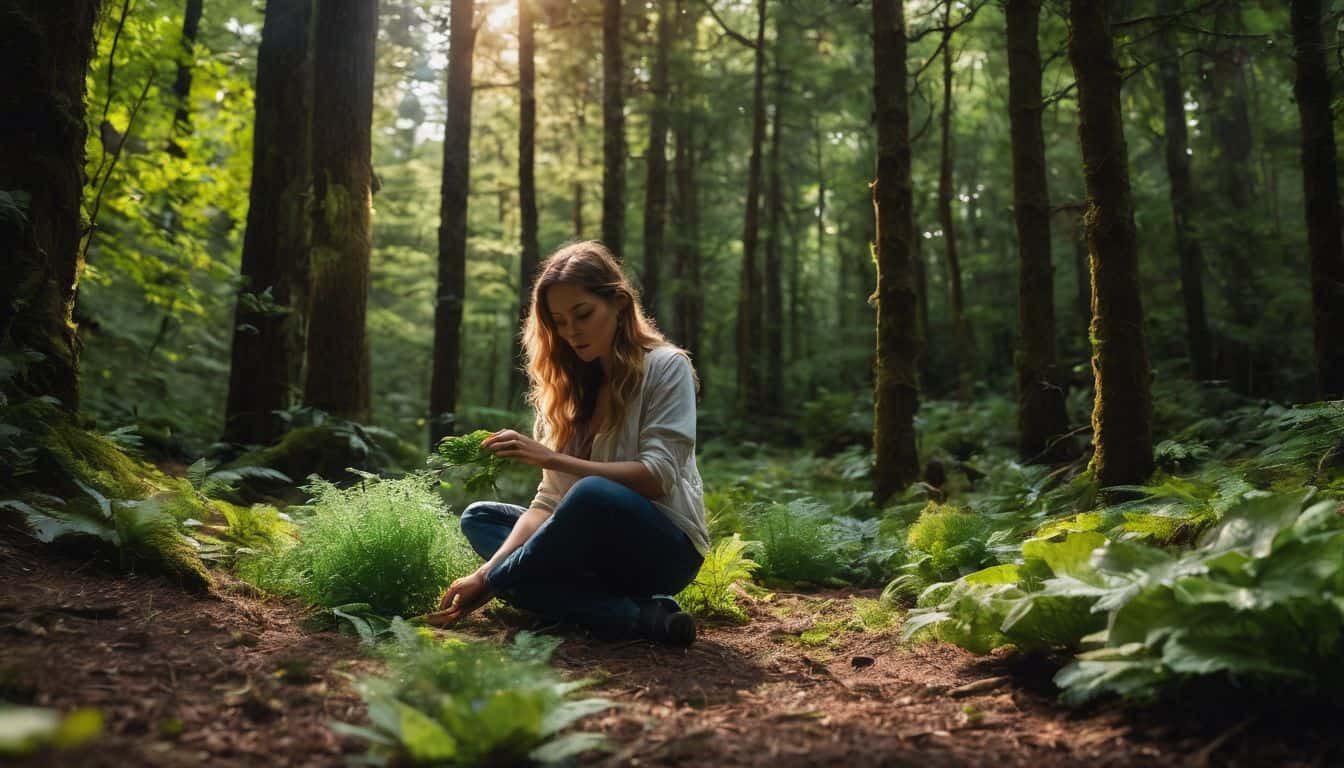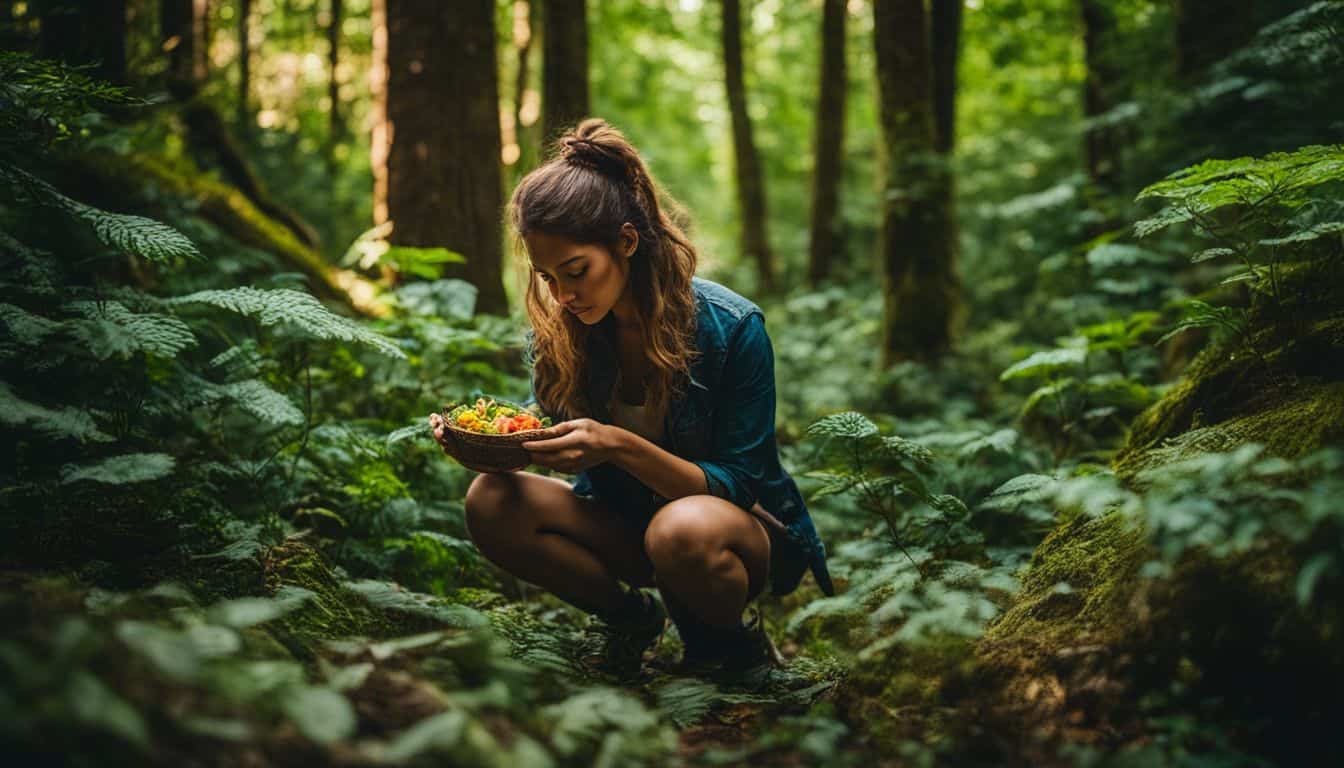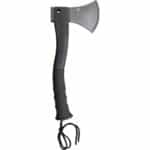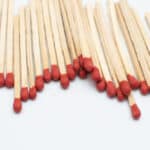Venturing into the wild to find your food can be daunting, especially when you’re new to spotting what’s safe to eat. Foraging for edible plants is an ancient practice now gaining popularity as a sustainable way to gather fresh greens.
This beginner’s guide unveils the secrets of harvesting nature’s bounty safely and responsibly, teaching you how to recognize a delicious snack instead of a dangerous dud. Dive in and let nature’s garden amaze you!
Table of Contents
Key Takeaways
- Foraging involves gathering wild edibles from natural environments and requires knowledge of plant identification to avoid toxic species like poison hemlock.
- Beginner foragers should abide by guidelines such as confirming the identity of plants, familiarizing with their environment, harvesting responsibly, and recognizing poisonous plants.
- Common edible plants suitable for beginners include watercress, dandelions, wild strawberries, mint, nettles, wild garlic, elderflowers, blackberries, and sweet chestnuts.
- Ideal places to forage are forests and fields away from pollutants; avoid roadsides or private property without permission.
- Safety in foraging extends to using guides for correct identification of safe-to-eat plants and practicing sustainability to protect ecosystems.
Understanding Foraging

Now that we’ve introduced the idea of foraging let’s dive into what it actually involves. Foraging is the practice of gathering wild edibles from their natural environment, whether that be a forest, a field, or even your own backyard.
It’s about more than just picking plants; it requires knowledge and respect for nature to ensure sustainable harvesting practices are followed. Building an understanding of plant identification is crucial because mistaking edible plants for poisonous ones like poison hemlock or water hemlock can have dangerous consequences.
Beginners should start simple: focus on easily recognizable species such as common dandelions and stinging nettles before moving onto less familiar vegetation. Recognizing the difference between savory ramps and look-alike lily-of-the-valley is important not only for safety but also to prevent disrupting sensitive ecosystems by mistakenly removing non-target species.
Equally important is knowing how environmental impact factors in—for example, avoiding areas where pesticides might be used or soil contamination could occur ensures that you’re collecting clean and healthy edibles like wild garlic or elderflowers without harming yourself or the environment.
Basic Rules for Beginner Foragers

Embarking on a journey into the wild to gather food might charm many enthusiasts, but it’s crucial for beginners to abide by some fundamental protocols. These guidelines not only ensure safety and respect for nature but also pave the way for an enriching and sustainable foraging practice.
Exercise caution
Always confirm the identity of plants before you eat them to avoid dangerous mistakes. Poisonous look-alikes can be mistaken for edible species, and one simple error could lead to serious health problems or worse.
Carry a reliable field guide with clear photographs, or consult an experienced forager to help you learn the ropes. It’s essential that every plant you pick is something you recognize without a shadow of doubt.
Double-check your surroundings before harvesting; polluted areas near roads or industrial zones are a no-go due to contamination risks. Use containers made from natural materials like baskets, which allow your finds to breathe and reduce moisture build-up compared to plastic bags that may accelerate decay.
Clean tools between harvests minimize spreading diseases among plants, ensuring the ecosystems remain balanced and thriving. Engage all your senses during identification – many edible plants have unique textures, colors, or scents that set them apart from their toxic twins.
Familiarize with your environment
Getting to know your environment is key when you’re out foraging. It involves more than just recognizing plants; it’s about understanding the local ecosystems and spotting the signs of healthy, uncontaminated areas where wild plants thrive.
Look around for clear water sources, as they often nurture plant life rich in nutrients like vitamin C – think lush patches of watercress or vibrant Stellaria media. But be wary of places near busy roads or industrial sites where pollution could affect plant purity.
Observing the habits of wildlife can also clue you into what’s edible and abundant. Birds and animals tend to graze on safe, nutritious foliage, so their feeding grounds might lead you to some prime foraging spots.
Just make sure these spots aren’t home to invasive species that could choke out native edibles or toss the ecosystem off balance. Get familiar with local Allium Ursinum (wild garlic) habitats or Sambucus nigra (elder trees), which offer bountiful harvests without damaging nature’s delicate web.
Harvest responsibly
Harvesting responsibly means taking only what you need and ensuring the plants can continue to thrive. Use a sharp knife to clip leaves, stems, or berries with care. This way, future foragers and wildlife will have plenty to discover as well.
Do not disrupt young saplings or rare species; focus instead on more abundant plants like dandelion greens that can handle being picked.
Keep in mind that sustainability is key when adding wild foods to your diet. Steer clear of plastic containers, which can harm the environment; opt for reusable bags or baskets instead.
By embracing these practices, we ensure our natural areas remain healthy and productive for everyone’s enjoyment. Next up: focusing on edible weeds—a treasure trove of overlooked nourishment right under our feet!
Focus on edible weeds
Edible weeds are often overlooked treasures hiding in plain sight. Many of these spontaneous plants can provide a burst of flavor and nutrition to your meals with minimal effort. For example, dandelion greens add a pleasantly bitter touch to salads and are packed with vitamins A, C, and K.
Young nettle leaves, known scientifically as Urtica dioica, make for an excellent spinach substitute once cooked; they lose their sting and retain their high nutrient content. These versatile wild plants can be turned into pesto or simply sautéed with garlic cloves for a quick side dish.
Venturing into the world of edible weeds also opens up opportunities for unique culinary creations. Oxalis presents a lemony zest perfect for brightening up dishes or even concocting refreshing margaritas.
Good King Henry, an ancient vegetable still popular among herbalists today, serves up similar flavors to quinoa when the seeds are prepared properly. With so many delicious options available just outside your door, exploring edible weeds is both sustainable and satisfying – offering fresh alternatives to intensively farmed vegetables while reducing pressure on pests that target traditional crops.
Tread lightly
As you shift your focus to edible weeds, consider how each step you take in nature should minimize impact. Treading lightly isn’t just about where you place your feet; it’s adopting the philosophy of Leave No Trace to ensure foraging areas remain plentiful and healthy for future visits.
Make every effort to disturb the environment as little as possible by using trails whenever they’re available and stepping carefully around plants.
Paying close attention to how much and which parts of a plant you harvest is a crucial aspect of treading lightly. It’s important not only for the sustainability of wild edibles but also so that other creatures who rely on these plants can continue to thrive.
Stick to taking only what you need, usually less than a third of any given plant or area, so that it can recover quickly. This approach demonstrates respect not just for nature but also solidifies sustainable practices essential in minimizing our ecological footprint while indulging responsibly in nature’s bounty.
Recognize poisonous plants
Recognizing poisonous plants is crucial for safe foraging. Before you head out, study up on the local flora and learn to identify harmful species like pokeweed or conium maculatum, commonly known as poison hemlock.
These look-alikes can fool an untrained eye, so it’s important to know their distinct features. For instance, poison hemlock has purple spots on its stem and an unpleasant smell when crushed.
Always cross-reference what you find with reliable sources. Use field guides, apps, or join a guided forage tour led by experts in plant identification. A mistake could lead to serious illness or worse, some plants contain toxins that are not eliminated by cooking or boiling.
Keep your explorations enjoyable and safe by being diligent about which plants you pick and consume.
Tips for Successful Foraging
Foraging for wild edibles is an adventure that requires skill and knowledge. Here are key tips to help you forage successfully and safely:
- Trust your senses: Use sight, smell, and touch to help identify plants accurately, but avoid tasting until you’re certain of a plant’s safety.
- Clean your tools: Before and after gathering plants, ensure your knives, baskets, and gloves are clean to avoid cross-contamination.
- Look for weedy areas: Weeds often indicate disturbed soils where many edible plants like dandelions and nettles thrive.
- Practice sustainability: Only take what you need and focus on abundant species to prevent overharvesting.
- Avoid contaminated areas: Steer clear of places near roads or industrial zones where soil and water may be polluted with chemicals.
- Learn from experts: Join guided forages or workshops to gain experience from knowledgeable instructors who can show you the ropes.
- Know the laws: Familiarize yourself with local regulations regarding land access and plant collection to stay within legal boundaries.
- Document findings: Keep a journal with notes and photos to track the locations and growth stages of plants you discover.
- Be patient: Mastering plant identification takes time, so be prepared to study plants across seasons before harvesting.
- Use technology wisely: Consider apps designed for plant identification as a supplementary tool alongside traditional field guides.
Common Edible Plants for Foraging
Delving into the world of foraging, you’ll discover a bounty of common plants that are not only safe to eat but can add unique flavors and health benefits to your meals. From the peppery punch of wild watercress to the unexpected sweetness found in ripe blackberries, nature’s garden is rich with edible treasures waiting to enhance your culinary creations.
Watercress
Watercress emerges as a superstar among wild edibles, perfect for those just dipping their toes into the world of foraging. This peppery plant thrives in clear, running water and often grows in abundance, making it a sustainable choice for beginners eager to add some zing to their meals.
Its tender leaves can elevate a simple salad or sandwich with a distinct, spicy flavor.
Finding watercress is relatively straightforward—look for its small, green leaves and delicate white flowers near natural water sources. Use the “Universal Edibility Test” to ensure safety before consumption; this involves separating parts of the plant and testing them incrementally for adverse reactions.
Watercress not only packs a potent taste but also brings substantial nutritional value to your plate—just be sure to harvest from clean, unpolluted waters to avoid contamination.
Incorporating this aquatic herb into your kitchen repertoire could mean spicing up traditional dishes or even creating pickled delights that capture its unique essence.
Dandelions
Dandelions are a treasure for beginner foragers, flourishing almost everywhere and recognized by their bright yellow blossoms. Often dismissed as mere weeds in your lawn, these hardy plants hold a wealth of nutritional value.
You can eat the entire dandelion—from its bitter greens that liven up salads to the roots that can be roasted and ground into a coffee substitute. Their flowers add a sweet touch to homemade jellies or pastries.
Incorporating these sunny blooms into your diet is not only easy but also beneficial, as they’re packed with vitamins A, C, and K. Stir-fried dandelion greens can give a slightly bitter yet gourmet twist to an ordinary meal, and pairing them with applesauce or tomatoes helps balance out the flavors.
Think of them as more than just garden invaders; they’re an untapped resource sitting right in your backyard, ready to enhance your staple diet without impacting intensive farming practices.
Wild Strawberry
Wild strawberries are a delightful find for beginner foragers. Unlike the common garden varieties, these small berries pack a punch of flavor that easily elevates jams, pastries, and cakes.
Their bright red color and heart shape signal ripeness and sweetness, luring in those with an eye for nature’s treats. Spotting these little gems among the foliage is both exciting and rewarding; just be sure to leave some behind for wildlife relying on them as a food source.
Foraging wild strawberries requires keen observation as they often grow low to the ground amid green leaves that provide camouflage. They’re not only delicious but also nutritious, offering vitamin C and antioxidants.
However, it’s crucial to ensure you’re picking true wild strawberries and not their look-alike counterparts, which can be harmful if consumed. Once you’ve identified and harvested these berries safely, incorporate them into your diet for a taste of wilderness infused with subtly sweet notes reminiscent of summer’s essence.
Mint
Mint thrives in many environments, making it a go-to plant for beginner foragers. You can identify this refreshing herb by its unique square stem and invigorating scent. This hardy green is often found along streams or moist soil, but be cautious—it’s essential to ensure the water source isn’t contaminated.
Adding mint to your haul introduces vibrant flavors that enhance dishes ranging from savory salads to sweet jellies.
Foraging mint opens up culinary possibilities, as its leaves are perfect for steeping in hot tea or muddling into summer drinks. Imagine walking through a meadow, picking sprigs of wild mint, and knowing they’ll soon add zest to your homemade pastry creations or offer a cooling twist to your lemonade.
After gathering some aromatic mint, next on the list could very well be nettles—a plant with as much sting as potential!
Nettles
Nettles might look unassuming, but they’re a forager’s treasure, packed with flavor and nutrients. Beginners will find nettles relatively easy to identify with their distinct stinging hairs and heart-shaped leaves.
Just make sure you’ve got gloves on hand; those tiny hairs can give quite the sting if you handle them barehanded. Once you’ve secured your harvest, nettles become incredibly versatile in the kitchen.
You can whip up nourishing soups, add them to smoothies for a green boost, or dry them out for herbal teas.
Harvesting nettles doesn’t just mean grabbing as much as you can carry; responsible foraging is key to preserving these plants for future seasons. Use sharp scissors or pruning shears so that only the top tender leaves are taken without damaging the whole plant.
This way, nettles get to grow back quickly and continue thriving in their natural habitat. And remember, understanding where these medicinal plants grow is part of successful foraging—nettle patches often thrive near rivers and moist woodland areas, but steer clear from those growing near roads or possibly contaminated water sources.
Moving down our list of wild edibles brings us next to an all-time favorite – wild garlic.
Wild garlic
Moving from the sting of nettles to a more oniony flavor, wild garlic emerges as an excellent choice for new foragers. Its green leaves give off a distinctive scent that can help you identify it in woodlands or shaded areas.
You might find wild garlic near streams or moist soil where it thrives naturally. Use the tender leaves to add a garlicky kick to salads, soups, and pesto.
Harvesting wild garlic is straightforward: simply pluck the needed leaves, taking care not to uproot the entire plant so it can continue growing. This ensures future seasons will be just as plentiful for grazing on these flavorful greens.
Chefs prize wild garlic for its subtle hints of chive and green onion taste, making it ideal in dishes where you’d use traditional cultivated garlic.
Elderflowers
Elderflowers stand out among foraged plants with their delicate white blossoms and sweet fragrance. These flowers bloom in the wild and are easy to spot with their clusters of tiny, star-shaped petals.
Foragers value elderflowers for their versatility; they not only add a floral hint to foods but can also be transformed into medicinal syrups or refreshing cocktails.
Harvesting elderflowers requires careful timing as they peak in late spring to early summer. Snip the blooms gently into your basket, ensuring you leave enough on each bush to allow for future growth and support wildlife.
Their unique flavor pairs well with both sweet and savory dishes, inspiring homemade jelly creations or enhancing salads with subtle, aromatic notes. In using elderflowers, one embraces a tradition that marries the joy of discovery with the delight of tasting nature’s own bounty.
Blackberries
Moving from the delicate blossoms of elderflowers, blackberries offer a delightful shift as we explore forage-friendly fruits. These juicy gems are not only tasty but also packed with nutrients, making them a fantastic find on your foraging journey.
Look for ripe blackberries in late summer to early fall when they’re plump and dark purple to nearly black—a hint that they’re at their peak sweetness.
Blackberry bushes can be found along sunny edges of woods and thickets. They grow on thorny vines called brambles, which protect the fruit with their prickly armor. Wearing gloves can help keep your hands safe as you pick these delicious berries.
Be sure to collect only the firmest and darkest berries; they should come off the vine easily if they’re ready to eat. Enjoy them fresh, or add them to pies, jams, or smoothies for a burst of natural flavor and vibrant color.
Sweet chestnuts
Sweet chestnuts are a true forest treat that you might stumble upon while foraging. Unlike their look-alike, the inedible horse chestnut, sweet chestnuts have a spiny husk and pointed tip.
They can be gathered in the fall when they’re ripe and falling from the trees. Imagine walking through the woods and spotting these natural goodies nestled among fallen leaves—free snacking is just a bit of careful picking away!
Roast them on an open fire or boil them to bring out their slightly sweet, nutty flavors; they’re not just for holiday songs! Sweet chestnuts offer versatility in the kitchen, whether you blend their pulp into soup for added creaminess or chop them up as a stuffing ingredient.
Foragers appreciate these nuts not only as delicious but also as part of sustainable wild food gathering practices, ensuring they get all the goodness without harming nature’s balance.
Where to Forage and Where Not to
Venturing into the wild to forage can be exciting, but it’s crucial to know the right places. Forests and fields can be treasure troves of edible plants like wild nettle, morels, and lingonberries.
These environments are often untouched by chemicals, allowing nature’s pantry to thrive in its purest form. Seek out areas with rich biodiversity; these spots typically signify a healthy ecosystem where plants good for foraging are abundant.
However, steer clear from roadsides and industrial zones where pollutants gather. Plants in these locations might absorb harmful substances which makes them unsafe for consumption.
Also, avoid private property unless you have permission – trespassing can get you into trouble! Stick with public lands or participate in guided forages that teach sustainable practices while leading you to the best spots hidden away from common hazards.
Always make sure your chosen area is not under environmental protection laws that prohibit removing any plant life; this preserves natural habitats and ensures future generations will also enjoy what the wilderness has to offer.
Safety and Sustainability in Foraging
Foraging safely means knowing which plants are safe to eat. Each time you forage, bring a guidebook or use a trusted app to identify edible plants accurately. Avoid those that look unfamiliar, and steer clear of areas that may be contaminated by pesticides or pollutants – like busy roadsides or industrial zones.
Safety extends beyond just what you pick; it’s also about how you handle your finds. Wash greens thoroughly and cook them when necessary to kill off any potential bacteria.
Sustainability should be at the heart of all foraging activities. Only take what you need, and never strip an area bare of its vegetation. This practice allows plants to regenerate and provides food for wildlife as well as other foragers down the line.
Be mindful of local guidelines: some regions have rules on how much wild produce one can harvest legally. Stick with sustainable choices like dandelions or green onions, whose populations are plentiful enough not to be threatened by moderate harvesting.
Conclusion
As you set out on your plant-hunting adventures, remember that nature’s bounty offers a world of flavors. Keep your senses sharp and prioritize safety with every step you take into the wild greens.
With knowledge and respect for the environment, you’ll unlock the secrets of the land’s natural pantry. Embrace this green-thumb journey, where each leaf and berry connects you more deeply with our planet’s intricate web of life.
Happy foraging!
Can Edible Insects Be Foraged for as a Source of Survival Nutrition?
Foraging for edible insects for survival nutrition can be a valuable skill in certain situations. Insects are a good source of protein and other nutrients. With proper knowledge and identification, edible insects can provide essential nutrition in emergency situations. Learning to identify and prepare edible insects is a useful survival skill.
FAQs
What should I look for when foraging for edible plants?
When searching the wild, aim to identify flavors from plants like fiddleheads or sassafras leaves, and look out for psyllium husks and butternuts that can add unique tastes to your dishes.
Is it safe to pick any plant I find in the wild?
Not all plants are edible; some could be harmful. Always ensure you have proper guidance or reference material on hand to distinguish between safe and potentially dangerous plants.
Can I use foraged plants in my everyday cooking?
Absolutely! Foraged edibles, such as ginger or salty-tasting greens, can enhance your meals with new flavors and healthy options straight from nature.
How do I start learning about foraging if I’m a complete beginner?
Begin by researching credible sources or joining local foraging groups, which can provide valuable knowledge about identifying and harvesting edible wild plants safely.






















Leave a Reply